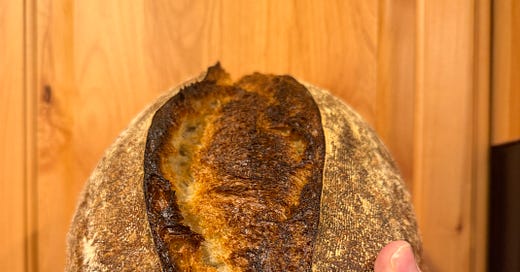My Daily Sourdough Loaf
This sourdough loaf is my go-to if I want bread and I'm not baking for the market. at 70% hydration it's simple to handle and completely delicious.
While I’m unable to do it very often due to time and responsibility constraints, I love ambient proofing sourdough bread. The crust darkens more deeply, the crust is crispy instead of crunchy and there is a depth of flavor compared to a cold-proofed loaf that disappears once the loaf is placed in the refrigerator.
We’re taking advantage of an increased prefermented flour percentage (PFF%) than normal. The prefermented flour in your recipe is the driving factor of your dough’s fermentation and you can increase or decrease the rate of your fermentation by increasing or decreasing your PFF. The PFF is calculated by dividing the flour in your sourdough starter by the total flour in your formula, which includes the flour in your sourdough starter. A typical sourdough recipe that you find in any cookbook or blog will sit around 9-11% PFF while this recipe uses 22.5% PFF
If you’ve never attempted it before I encourage you to try it! If you keep your dough warm enough (82°-84°F) this will come together in 5-ish hours.
Skip the autolyse if you want as I generally don’t do it, however I do find that my Ankarsrum mixes slightly more consistently with a brief autolyse.
If you don’t have access to rye flour, replace it with whole wheat or additional bread flour
Makes 2 900g loaves
Ingredients if using a liquid (100%) starter:
Low-protein (11.7%) bread flour - 773g
(Kirkland AP or KA All Purpose)
Rye flour - 41g
Water - 498g
Sea salt - 16g
Ripe liquid sourdough starter - 472g
Ingredients if using a stiff (60%) starter:
Low-protein (11.7%) bread flour - 773g
(Kirkland AP or KA All Purpose)
Rye flour - 41g
Water - 593g
Sea salt - 16g
Ripe stiff (60%) sourdough starter - 378g
Baker's Percentages
Flour - 95
Rye flour - 5
Water - 61.3
Sea Salt - 2
Starter - 58.1
Process:
1. Autolyse - 15-30 minutes before your starter is ready for use mix the flour and water until no dry flour remains. If using a mixer, mix on low until combined. Cover for 15-30 minutes
2. Add the starter and salt and fully incorporate. In a mixer mix on low speed for 8-10 minutes (2 on a kitchenaid) and on medium low speed (3/4 on a KA) for 1-3 until the dough pulls from the side of the bowl and has good strength to it. A windowpane is not necessary.
3. Write down the time and temperature of your dough to monitor the time of its bulk fermentation and transfer it to it's bulk fermentation container. Cover and let rest for 45 minutes
4. Using damp hands fold the dough and cover again. Repeat resting and folding every 30-45 minutes until the dough holds its shape in the container, 1-3 additional folds. If hand mixing you may need the full 3 additional folds.
5. After the final fold, cover and rest until the dough has obviously expanded, is very jiggle and covered with bubbles 2.5 to 3.5 hours from when your bulk fermentation started.
6. Once your bulk fermentation is finished, divide the dough and preshape. Bench rest if you'd like and shape as you normally would, covering loosly with a shower cap or other cover.
7. Proof the final loaf above 81°F until it fills your basket and springs back slowly after a poke test.
8. BAKING - at least 45 minutes before your loaf is ready preheat your baking vessel of choice. I preheat at 475°F.
9. Remove your loaf to a piece of parchment, baking sling or directly to your preheated baking vessel. Score and cover with your baking vessel's lid and return to the oven. Bake for 20 minutes
10. Remove the lid and reduce your oven temperature to 450°F and continue to bake until deeply browned, 20-30 minutes
11. Transfer the loaf to a rack and allow to cool fully, at least 2 hours, before slicing.





I learned this by accident. When starting out I used the Tartine Country loaf recipe which calls for 20% PFF. Each time, I would have to abbreviate my steps just to keep up with the rapid fermentation. I finally got the idea to reduce the PFF% by half and finally got a longer bulk and final proof. I wish I had read this article then, it would have saved me a lot of frustration.
Color looks great! I love the versatility of sourdough methods, always something new to learn! Can’t wait to try this, thank you